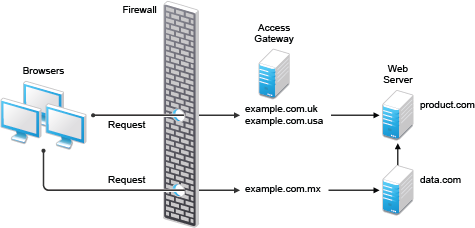Determining Whether You Need to Exclude DNS Names from Rewriting
If you have two reverse proxies protecting the same web server, the rewriter correctly rewrites the references to the web server so that browser always uses the same reverse proxy. If the browser requests a resource using example.com.uk, the response is returned with references to example.com.uk and not example.com.usa.
If you have a third reverse proxy protecting a web server, the rewriting rules can become ambiguous. For example, consider the configuration illustrated in Figure 2-13.
Figure 2-13 Excluding URLs

A user accesses data.com through the published DNS name of example.com.mx. The data.com server has references to product.com. The example.com.mx proxy has two ways to get to the product.com server because this web server has two published DNS names (example.com.uk and example.com.usa). The rewriter can use any of these to rewrite references to product.com.
-
If you want all users coming through example.com.mx to use the example.com.usa proxy, you need to block the rewriting of product.com to example.com.uk. On the HTML Rewriting page of the reverse proxy for example.com.uk, add product.com and any aliases to the Exclude DNS Name List.
-
If you do not need to know which proxy is returned in the reference, do not add anything to the Exclude DNS Names List.